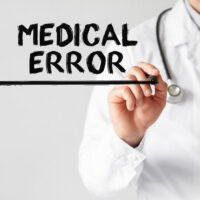REPORTING MEDICAL ERRORS IN INDIANA

It’s been fifteen years since then-Indiana Governor Mitch Daniels issued an Executive Order requiring our Indiana State Department of Health to implement a medical error reporting system. There were three purposes outlined:
- reduce the frequency of medical errors
- reveal the causes of medical errors
- empower healthcare professionals to design ways to prevent errors
Who is required to report adverse events?
- hospitals
- ambulatory surgery centers
- clinics
- birthing centers
After more than 40 years of dealing with medical malpractice cases, at Ramey & Hailey Law we believe that the following sentence in Indiana’s Medical Error Reporting System is very important:
“Medical errors generally are not the sole result of actions of individuals
but rather the failure of the systems and processes used in providing healthcare.”
In keeping with that statement, different entities may be liable for medical malpractice, such as:
- A provider – the doctor, nurse, or other healthcare professional who breaches the standard of care and causes injury to the patient.
- A facility – the hospital or other facility where the negligence occurred may be liable for the negligent actions or omissions of its employees
- An HMO – health maintenance organizations may commit malpractice by refusing to pay for necessary tests of treatment
Today, the Indiana Hospital Association website lists six different categories of adverse events that must be reported:
-
- surgical events
- product or device events
- patient protection events
- care management events
- environmental events
- criminal events
Last year marked two different milestones related to medical errors: the final changes to the Medical Malpractice Act put into place by Senate Bill 28 took effect, requiring all physicians to have medical malpractice insurance coverage of at least $500,000 per occurrence ($1.5 million in the aggregate per year). Meanwhile, the maximum amount of recoverable damages increased to $1.8 million.
On a chart comparing healthcare conditions in different states of the U.S., Indiana ranked “frail” (the next to worst rating). These ratings were based on several factors, including adequacy of doctors’ office and nursing home staffing, average cost per day of inpatient care, health insurance coverage and affordability, and percentage of child immunization.
It was true fifteen years ago and it is true today. Medical errors generally result from failure of the systems used in providing healthcare. The only path towards improvement is reporting. That means that individuals who have been hurt through medical malpractice must speak up, allowing legal professionals to bring matters of wrongdoing and neglect into the civil courts.
As medical malpractice attorneys, we not only help victims – and victims’ family members – get the financial compensation they need, our actions represent progress towards reducing the frequency of medical errors.




